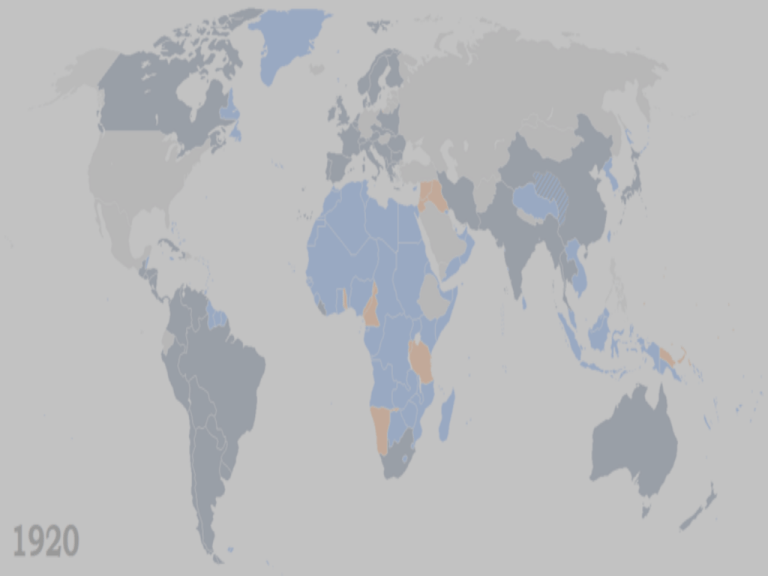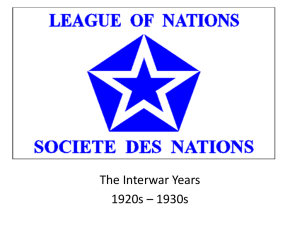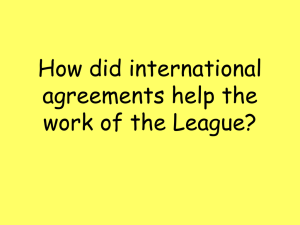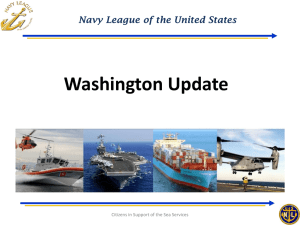League of Nations
advertisement

League of Nations •Met for the 1st time in December if 1920 •Initial membership was 32 Allied states and 12 neutral states, though all ex-enemy states had joined by 1926 •USSR was admitted in 1934 •USA never joined •How the League operated: •Articles 1-7 membership + structure of organization •Articles 8-17 prevention of war •Articles 18-21 treaty obligations of members •Article 22 mandated territories (A, B & C classifications) •Article 23 humanitarian issues (e.g. labour, trafficking in women, children & drugs, health issues and arms trade •Article 24 the special commissions •Article 25 promotion of the Red Cross •Article 26 how to amend Covenant League of Nations League of Nations Assembly Council •Debating chamber •All members rep., each w/ one vote •Unanimous decision •Met annually •Decision maker •Permanent: GB, Fr, It, Jap & Ger (post 1926) – had veto •Non-permanent: elected by Assembly Permanent Court of Justice Int’l Labour Organization •Advisors on economic and social issues •15 judges •Based in The Hague •Settle member disputes Secretariat •Administrative •Recorded decisions •Prepared reports Special Commissions Mandates Health Traffic in drugs, drink & arms Slavery Refugees Minorities Traffic in women & children Aid to underdeveloped states League of Nations •“[the League] depended on the goodwill of nations to work, though it was the absence of goodwill that made it necessary” Hugh Brogan, The Penguin History of the USA, 2001 “…successive British governments took care to confine any specific political military commitments they might make to Western Europe, although under article 10 of the League Covenant they had undertaken to ‘preserve…against external aggression the territorial integrity and existing political independence of all members of the League’” Ruth Henig, Versailles and After 1919-1933, 1995 League of Nations •“the allies had been so impressed by the effect of economic embargoes employed against Germany in the war that economic sanctions were chosen as the League’s main weapon. The possibility of military sanctions was admitted, but their extent was left undefined, and they could only ever be applied if a member state agreed to put its own forces at the disposal of the League.” R.M. Rayner, The Twenty Years’Truce, 1943 “Rival states can be frightened into friendship only by the shadow of some greater danger.” British historian A.J.P. Taylor League of Nations THE RABBIT: “My offensive equipment being practically nil, it remains for me to fascinate him with the power of my eye.” Punch magazine July 28, 1920 League of Nations •Aaland Islands 1920 •Vilna 1920-23 •Upper Silesia 1921 •Corfu 1923 •Mosul 1924 •Bulgaria 1925 League of Nations Attempts to strengthen the League/Collective Security 1922 Washington Four Power Naval Treaty: USA, GB, Fr & Japan – halted the building of capital ships for 10 years and est. a ratio of capital ships for each power (5 for USA & GB; 3 for Japan; 1.67 for France and Italy) *** Ruhr Crisis occurs*** 1923 The Draft Treaty of Mutual Assistance: sponsored by France, it would have required all League members to come to the assistance of victims of aggression. (rejected by Britain) 1924 the Geneva Protocol: sponsored by France, it called for a general disarmament and made arbitration compulsory in all disputes. (rejected by Britain) 1924 the Dawes Plan: US economist Charles Dawes offers the following plan at the London Conference: 1. Mortgage taken in German railways and industry + popular tax 2. US ‘reparations agent’ resides in Germany to supervise repayment 3. Amount of reparations reduced League of Nations League of Nations Conditions Improve 1925-30 the Locarno Era: •1925 the Locarno Treaties – Ger. Foreign Secretary Gustav Stresemann & Fr. Foreign Minister Aristide Briand agreed to settle all disputes by arbitration and the Franco-German border is formalized. Britain’s Foreign Secretary Austen Chamberlain signs as a guarantor. •1928 the Kellogg-Briand Pact - US Sec. of State William Kellogg & Aristide Briand sign a pact that “in the names of their respective peoples that they condemn recourse to war as a solution to international controversies, and renounce it as an instrument of national policy in their relations with one another.” •1929 the Young Plan – proposed by American Owen Young; reduced the total sum of reparations to be paid to to $112 billion to be paid over 59 year period & called for the Allied evacuation of the Rhineland (5 years early). •1930 the European Federation – proposed by Briand at the 10th League Assembly, called for a “federal link… between the peoples of Europe.” Stresemann also encourage a European customs union in addition to a common currency. League of Nations League of Nations The Depression •World trade falls by 70%. •US national income drops by almost 50% between 1929 and 1932, withdraws loans. •In France, the moderate government was replaced by a radical left-wing gov’t in 1932. •In Britain, iron and steel production dropped by 50% and politics shifted to right-wing parties. •In Germany, the loans stopped and the economy collapsed. Unemployment rose from 1.4 million in 1928 to 12 million in 1932. The Weimar gov’t lost credibility and Franz von Papen assumes control in 1932. •In Japan, 50% of the factories closed and silk production fell by 67%. Military factions carried out a series of assassinations and the radical right took over. •As governments became increasingly protectionist (economically and militarily), tensions mounted. Economic sanctions were no longer a viable option as most countries were afraid of the impact it would have on their own countries. Without the means or resolve to resist aggression, many began to turn to appeasement to solve growing concerns. League of Nations The Manchurian Crisis 1931-33 League of Nations The Manchurian Crisis •In Sept. 1931, a bomb (planted on a train by the Japanese) exploded near Mukden giving the Japanese the excuse to invade Manchuria (mineral rich area of China) •The Kwantung Army sets up the puppet government of Manchukuo. •China appeals to the League for arbitration (both are members) 1. Orders withdrawal of Japanese forces (Japanese gov’t agrees, but army refuses) 2. Est. a commission under Lord Lytton to investigate (takes a year to report) 3. League instructed not to recognize Manchukuo, but to give Manchuria back to China •Japan withdraws as member of the League in 1933, stating that the powers were guilty of hypocrisy. League of Nations The Manchurian Crisis Why did the League fail to resolve this issue, especially since this was a clear case of open aggression by one League member against another? What impact did the crisis have on the League? 1. The affair suggested that the League would not follow through on its philosophy of collective security. 2. The exodus from the League set a precedent that others were soon to follow. 3. With Japan’s departure, the Far East was removed from the international system of collective security. 4. Once Japan “got away with it”, Mussolini began planning his expansionist adventure into Abyssinia. League of Nations The Abyssinian Crisis League of Nations The Abyssinian Crisis . •In 1932, Mussolini begins to plan invasion of Abyssinia (Ethiopia and Eritrea) in an effort to build a North African empire (though mainly to distract Italians from economic pressures at home. •The first clash was at the Wal-Wal oasis in December of 1934, though the full scale invasion (100K troops strong) did not begin until October 3, 1935. •In the face of brutality and ferocity, Abyssinian Emperor, Haile Selassie, appealed to the League. League of Nations The Abyssinian Crisis •The French and British were hesitant to alienate the Italians, as they assumed that only a strong alliance with Italy would keep the increasingly aggressive Nazi Germany in check •Though the League officially condemned the invasion, they looked for a settlement outside of the League •In December, British For. Sec. Samuel Hoare and French For. Min. Pierre Laval suggested that Italy be given 2/3 of Abyssinia in the Hoare-Laval Pact, but plan was leaked, was shot down by British public condemnation •By May of 1936, Italy controlled Abyssinia League of Nations The Abyssinian Crisis What impact did this crisis have on the League? 1. The affair again proved that the League would not follow through on its philosophy of collective security. 2. Italy, now isolated from its former allies, moved closer to Nazi Germany. The weakness was exposed for Hitler to exploit, which he rapidly did by remilitarizing the Rhineland in March of 1936. 3. As the “final nail in the League coffin”, the League was never able to exert authority again.











